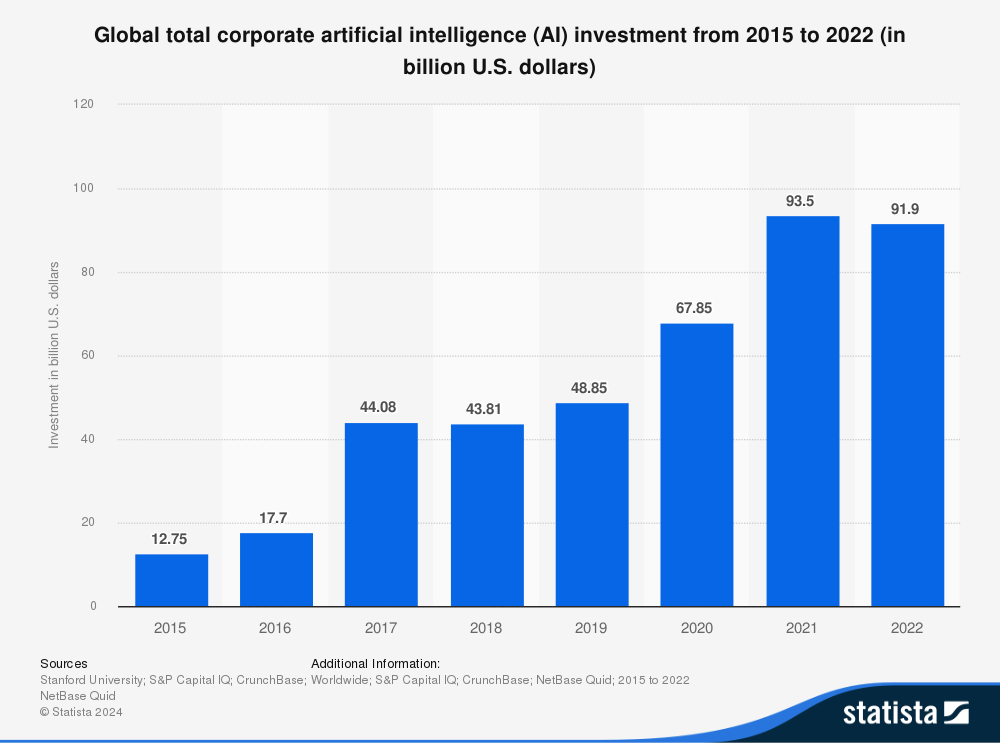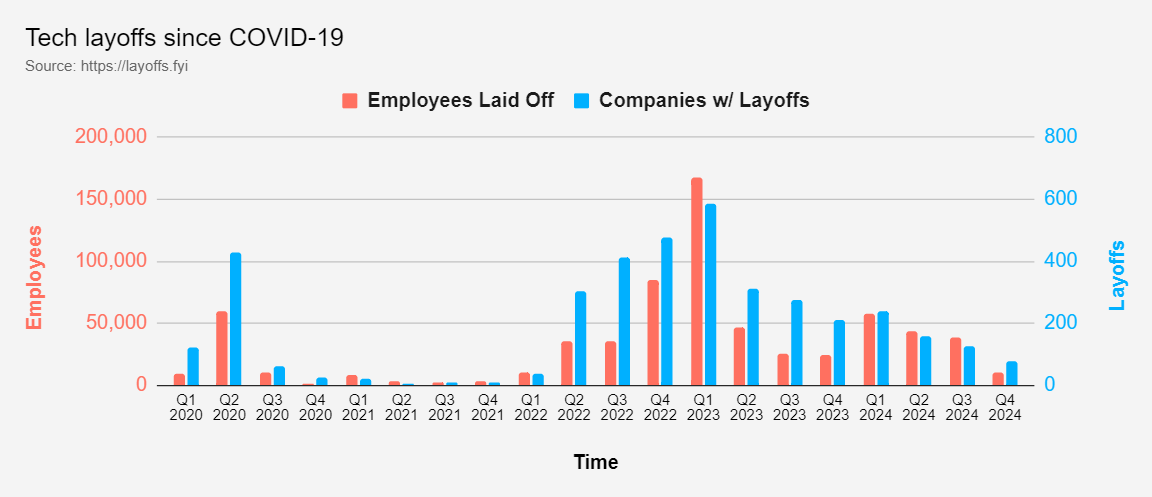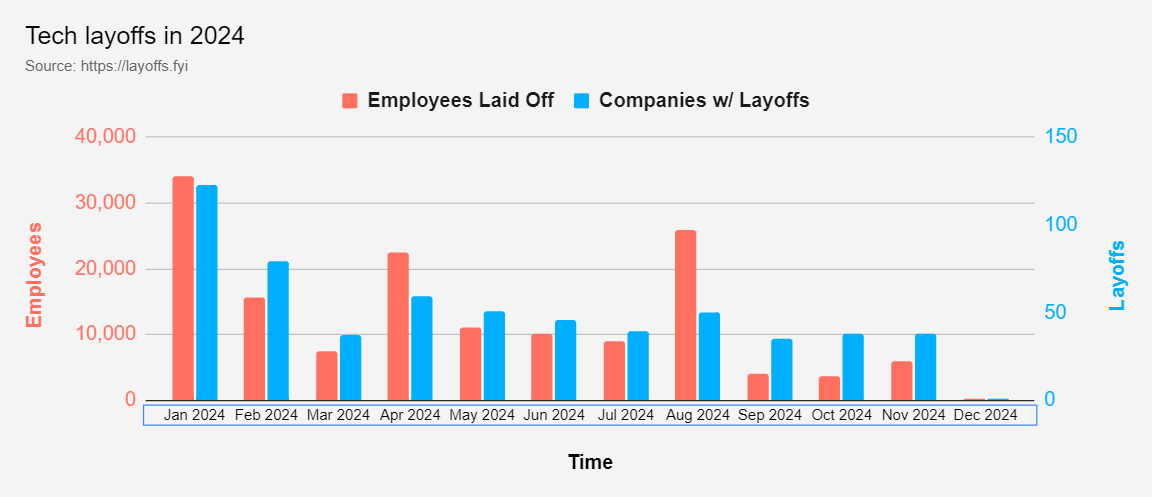Artificial Intelligence
81 AI and Jobs In The Technology Industry
Robert Dunn
Artificial Intelligence (AI): The simulation of human intelligence in machines that are programmed to think and learn like humans. These intelligent systems excel at performing repetitive tasks with high efficiency and accuracy, such as data entry, scheduling, and basic customer service interactions. AI can also handle more complex tasks like visual perception, speech recognition, decision-making, and language translation (Stryker & Kavlakoglu, 2024).
The Impact of AI on Layoffs in the Technology Industry
Artificial Intelligence (AI) is revolutionizing the technology industry, but not without significant consequences. One of the most pressing issues is the wave of layoffs attributed to AI advancements. AI implementation and development is the driving cause behind layoffs in the technology industry post COVID-19. This chapter explores how AI is reshaping the job landscape, causing both excitement and concern among tech professionals.
Connecting to Science, Technology, and Society (STS)
The intersection of AI, layoffs, and the broader societal impacts is a prime example of the Science, Technology, and Society (STS) framework. STS examines how scientific and technological advancements influence and are influenced by social, cultural, and economic factors. In the case of AI-induced layoffs, we see a clear interplay between technological innovation and societal change. AI is not just a technological advancement; it is a catalyst for significant shifts in labor markets, economic structures, and social dynamics. This transformation raises ethical questions about the responsibility of tech companies to their employees and the role of government in mitigating negative impacts through policy and regulation. By understanding these connections, we can better navigate the challenges and opportunities presented by AI, ensuring that technological progress benefits society as a whole.
The Rise of AI and Job Displacement
AI’s rapid development has led to increased efficiency and automation in various sectors. Companies like Google, Microsoft, and SAP are investing heavily in AI technologies (Hoover, 2024; Skelton, 2024). For instance, SAP announced a $2 billion investment in AI, which coincided with plans to restructure 8,000 roles (Hoover, 2024). This restructuring often involves retraining employees to work with AI, but it also means that many roles become redundant, leading to layoffs. The shift towards AI is driven by the promise of increased productivity and cost savings, but it also raises questions about the future of work and the need for new skills.
COMPARING SOURCES ON AI AND JOB LOSSES
Goldman Sachs predicts that AI could impact up to 300 million jobs globally, with 7% of US jobs potentially being replaced by AI (Kelly, 2023). The report highlights that while AI will automate many tasks, it will also complement a significant portion of jobs, leading to a transformation rather than a complete elimination of roles. The prediction underscores the potential for significant disruption in the labor market, particularly in sectors like office and administrative support, legal, and architecture and engineering (Kelly, 2023).
Statista provides data on the substantial investment in AI technologies, with global AI investment reaching $119 billion in 2022 (Statista, 2023). Major tech companies like Google and Microsoft are leading the charge, acquiring numerous AI startups and investing heavily in AI development. This surge in investment is driven by the promise of increased productivity and efficiency, which in turn fuels the adoption of AI across various industries (Statista, 2023).
The comparison of these sources suggests a strong correlation between increased AI investment and job displacement. As companies invest more in AI, they are likely to automate tasks that were previously performed by humans, leading to job losses in certain sectors. However, this investment also drives the creation of new roles that require different skills, highlighting the dual nature of AI’s impact on the job market. While some jobs are lost, new opportunities arise, necessitating a shift in skills and continuous learning.
The Numbers Behind the Layoffs
In 2023, 37% of business leaders reported that AI had replaced workers in their companies (Council of Economic Advisers, 2024). This trend is expected to continue, with 44% predicting further layoffs in 2024 due to AI efficiencies (Council of Economic Advisers, 2024). Major tech firms have already cut over 100,000 jobs in 2024 alone (Seeking Alpha, 2024). These numbers highlight the significant impact AI is having on employment, particularly in roles that involve routine and repetitive tasks. The data underscores the urgent need for policies and programs that support workers in transitioning to new roles and acquiring new skills.
Chart from Statista. (2023)
Charts from Layoffs.fyi. https://layoffs.fyi/ (Retrieved, December 2024)
The Dual Nature of AI’s Impact
While AI is causing job losses, it’s also creating new opportunities. AI can handle repetitive tasks, allowing humans to focus on more complex and creative work. This shift is similar to the mid-20th century when word processors replaced typists, leading to new roles in managing and interpreting data (Acemoglu et al., n.d.). Companies are not just cutting jobs; they are also redefining them. For example, roles that involve data analysis, AI programming, and machine learning are in high demand. This dual nature of AI’s impact means that while some jobs are lost, new ones are created, often requiring different skills and expertise.
Case Studies: Tech Giants and AI
Google’s recent layoffs in its ad sales team highlight the direct impact of AI on employment (Hoover, 2024). Similarly, Microsoft is investing billions in AI while simultaneously reducing its workforce (Hoover, 2024). These companies are at the forefront of AI innovation, demonstrating both the potential and the pitfalls of this technology. For instance, Google’s use of AI to optimize ad placements has reduced the need for human intervention, leading to job cuts. On the other hand, Microsoft’s investment in AI is creating new roles in AI development and deployment, showcasing the complex dynamics of AI’s impact on employment.
The Future of Work in the AI Era
The future of work in the AI era is uncertain but promising. AI’s ability to perform task-based work efficiently means that humans can move up the value chain, focusing on strategic and creative tasks (Acemoglu et al., n.d.). This transition requires a shift in skills and mindset, emphasizing the importance of continuous learning and adaptability. Workers will need to develop skills in areas such as data analysis, machine learning, and AI ethics. Educational institutions and employers will play a crucial role in providing the necessary training and resources to help workers adapt to these changes.
Conclusion: Embracing Change
AI is undeniably transforming the technology industry, leading to both job displacement and creation. As we navigate this new landscape, it’s crucial to embrace change and prepare for the future. By understanding the dual nature of AI’s impact, we can better equip ourselves to thrive in an AI-driven world. This involves not only adapting to new technologies but also fostering a culture of continuous learning and innovation. Policymakers, educators, and industry leaders must work together to ensure that the benefits of AI are shared broadly and that workers are supported in their transition to new roles.
References:
Acemoglu, D., Autor, D., Hazell, J., & Restrepo, P. (n.d.). Artificial Intelligence and Jobs: Evidence from Online Vacancies. Retrieved from https://shapingwork.mit.edu/wp-content/uploads/2023/10/Paper_Artificial-Intelligence-and-Jobs-Evidence-from-Online-Vacancies.pdf
Council of Economic Advisers. (2024, March 21). The 2024 Economic Report of the President. The White House. Retrieved from https://www.whitehouse.gov/cea/written-materials/2024/03/21/the-2024-economic-report-of-the-president/
Hoover, A. (2024, June 17). AI Is Coming for Big Tech Jobs—but Not in the Way You Think. Wired. Retrieved from https://www.wired.com/story/ai-is-coming-for-big-tech-jobs-but-not-in-the-way-you-think/
Kelly, J. (2023, March 31). Goldman Sachs predicts 300 million jobs will be lost or degraded by artificial intelligence. Forbes. Retrieved from https://www.forbes.com/sites/jackkelly/2023/03/31/goldman-sachs-predicts-300-million-jobs-will-be-lost-or-degraded-by-artificial-intelligence/
Seeking Alpha. (2024, July 14). AI plays role as tech layoffs surpass 100,000 in 2024. Seeking Alpha – Premium News. Retrieved from https://advance-lexis-com.libproxy.clemson.edu/api/document?collection=news&id=urn%3acontentItem%3a6CGF-JK91-F11P-X415-00000-00&context=1519360&identityprofileid=P62HG851805
Skelton, S. (2024, August 22). Tech sector layoffs Mount Amid AI Investment Frenzy: Computer Weekly. ComputerWeekly.com. Retrieved from https://www.computerweekly.com/news/366606035/Tech-sector-layoffs-mount-amid-AI-investment-frenzy
Statista. (2023). AI investment and funding worldwide. Retrieved from https://www.statista.com/statistics/941137/ai-investment-and-funding-worldwide/
Stryker, C., & Kavlakoglu, E. (2024, October 25). What is Artificial Intelligence (AI)?. What is AI? – IBM. https://www.ibm.com/topics/artificial-intelligence
Vaughan-Nichols, S. (2024, April 4). Is AI driving tech layoffs?. COMPUTERWORLD. Retrieved from https://www.computerworld.com/article/2077751/is-ai-driving-tech-layoffs.html
iMAGES
Layoffs.fyi. https://layoffs.fyi/
ai Acknowledgments
Microsoft Copilot was utilized to help organize sections and references, and enhance the overall clarity and readability of the text. All sources and research were found and compiled manually. The insights and conclusions drawn in this article are based on independent research and analysis.
**Special thanks to Professor Anne Grant, a professor, librarian, and historian, for her invaluable assistance in finding sources.




